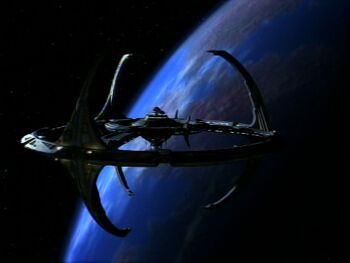Nor class
History
The Nor class starbase was developed by the Cardassian Union in 2310, with the intention of it performing what was essentially a civilian role, but also being capable of operating as a military base, to enhance the Union's defensive capabilities. Utilised primarily for both Trade and for ore processing (such as uridium), the station carried both impressive trading facilities as well as the ability to repair and entertain ships crews, as well as to provide advanced ore processing capability to Cardassian mining operations.
The Nor class starbase has become a common sight around the Union, her low resource cost and ease of construction making her a highly desirable station, especially when it is noted the boost she provides to a local economy.
In addition to this many Nor class starbases were used by the Union to facilitate occupations of "client worlds" the Union had decided to annex and essentially rape for resources to fuel the Cardassian state's insatiable desire for raw materials. The most notable example of this was the occupation of Bajor, during which the Cardassian station, Terok Nor became infamous as did her Commanding Officer, Gul Dukat. Both would go on to play a major role in interstellar politics and prove the worthiness and adaptability of the Nor design, even if she didn't always mesh smoothly with Federation technology.
The Nor class starbase has proven herself to be an invaluable design and will most likely continue in service with the Union for the forseeable future.
Description
The Nor's structure was unusual by Federation standards, classified by Starfleet as a "hybrid planar-columnar triradial structure". Its basic form consisted of a central core assembly containing most primary systems, connected by crossover bridges to a series of two concentric rings for habitat and docking facilities, and a series of three sweeping pylons containing ore-processing and additional docking facilities. The station had at least five transporter rooms, with the handful of versions taken over by Starfleet being upgraded to a total complement of nine for personnel and additional cargo transporters.
The central core was a roughly cylindrical structure consisting of several terraced platforms containing various key facilities. At the extreme dorsal end of the core was the operations center and the subspace communications antennae, as well as the deflector shield generators. Below this assembly was the three-level Promenade, a public area for commerce and recreation. The Promenade also housed the station's infirmary, the security office and the Bajoran temple.
The lower sections of the core contained engineering and support facilities, including at least one large industrial replicator, the computer core, and multiple deuterium fuel tanks. At the extreme ventral end sat the six fusion reactors.
The command level is part of the central core of the Nor Class. The command level was the primary operations center for the station. It contained primary access to all major operations of the station including science, tactical, and flight control. It also contained the office of the commanding officer.
The habitat ring was the inner ring of the station's structure, intended primarily for the housing of most of the station's semi-permanent residents. Spaced along the ring were also six landing pads, used by Starfleet's runabouts and other small craft. The station itself could accommodate 7,000 people; whether this was the number of permanent residents or not was not clarified.
Also mounted along the habitat ring were three large protrusions, upon which a large portion of the station's armaments were mounted, as well as its tractor beams. The habitat ring is also the place where the weapons were stored. They were located in level five, section three and restricted to security clearance seven and above.
The docking ring was the outer ring of the station's structure, and was used primarily for moving and storing goods and for starship docking facilities. Twelve large docking ports were distributed around the perimeter, and numerous cargo bays were connected to these facilities. In addition, a series of six thrusters were mounted on the edge of the ring. These thrusters were intended mainly for maintaining orbital position.
Three large, sweeping docking pylons emerged from the dorsal and ventral surfaces of the docking ring to give the station its characteristic spindly shape. At the extreme end of each pylon was an additional docking port (for a total of six on the pylons), which could accommodate larger starships up to those approximately the size of the Galaxy class. The majority of the pylons' internal structure was used up by ore processing facilities. The docking ports where the docking pylons intersected the main structure had the capability of launching probes.
Auxiliary Craft
- Hideki class: 9
- Kanvek class: 36
- Kourak class: 24
Armament
- System 5 disrupter: 18
- Heavy Spiral wave banks: 30
- Nor type torpedo launcher: 48
- Photon torpedo: 4500
- Starbase Shielding System
